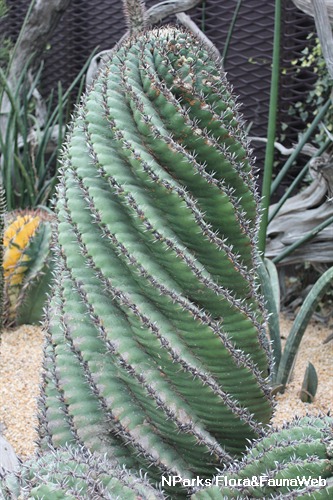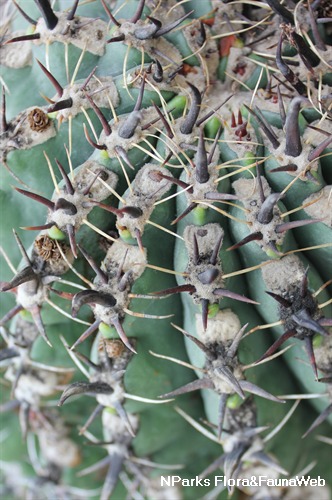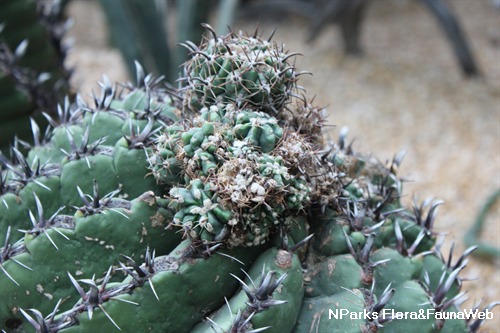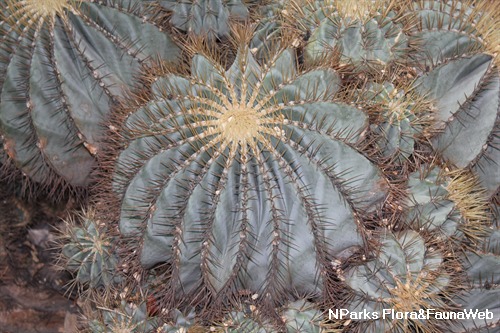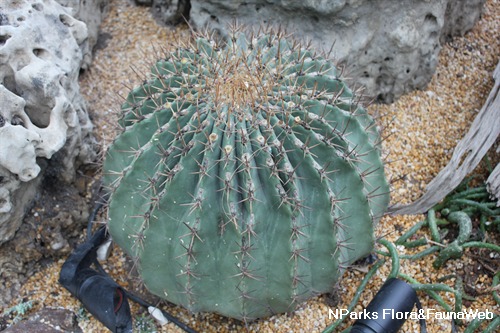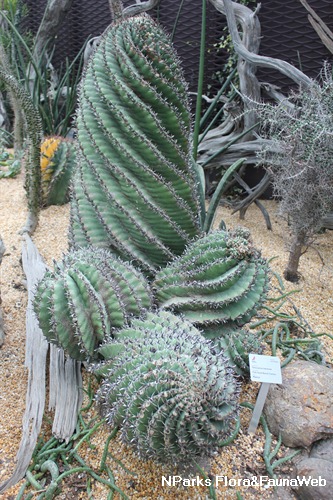
Back
Ferocactus herrerae Ort.
| Family Name: | Cactaceae |
| Synonyms: | Ferocactus wislizeni (J. G. Ortega) N. P. Taylor var. herrerae |
| Common Name: | Fish-hook Barrel Cactus, Twisted Barrel Cactus, 偉刺仙人球 |
Name
Classifications and Characteristics
| Plant Division | Angiosperms (Flowering Seed Plants) (Dicotyledon) |
|---|---|
| Plant Growth Form | Shrub |
| Lifespan (in Singapore) | Perennial |
| Mode of Nutrition | Autotrophic |
| Plant Shape | Columnar |
| Maximum Height | 2 m |
| Maximum Plant Spread / Crown Width | 0.4 m |
Biogeography
| Native Distribution | Mexico |
|---|---|
| Native Habitat | Terrestrial (Desert / Semi-Desert) |
| Preferred Climate Zone | Desert / Arid |
| Local Conservation Status | Non-native |
| CITES Protection | True |
Description and Ethnobotany
| Growth Form | Cactus with a cylindrical form up to 2 m tall. |
|---|---|
| Stems | Stem is composed of 13 ribs which are straight to spirally arranged. Ribs are densely armed with areoles composed of 7-9 central spines (1 of which is longer than the rest, thick, flattened and hooked at the tip) and a varying number of whitish to grey radial spines depending on age. |
| Flowers | Funnel-shaped flowers are composed of yellowish, triangular petals with dark red midribs. |
| Fruit | Yellowish green, fleshy fruit (4-6 cm long, 2.5-3 cm wide) contains small, black seeds (2.5 mm long). |
| Habitat | Occurs along coastal plains at altitudes up to 400 m. |
| Cultivation | This species requires a very, well-drained soil mix. In the wild, this species receives an abundant amount of rain in 2 months of the year and then experiences dry conditions for the rest of the year. In cultivation, it is important to prevent the stem from getting wet, because wet plants under full sun may become sunburned. |
| Ethnobotanical Uses | Edible Plant Parts : Edible Fruits Others: In the past, seeds were ground and made into flour. |
Landscaping Features
| Desirable Plant Features | Ornamental Stems, Ornamental Form |
|---|---|
| Landscape Uses | Container Planting |
| Thematic Landscaping | Rockery / Desert Garden |
| Usage Hazard - Cons | Spines/Thorns - Stem/Branch |
Fauna, Pollination and Dispersal
| Pollination Method(s) | Biotic (Fauna) (Insects (Bee)) |
|---|
Plant Care and Propagation
| Light Preference | Full Sun |
|---|---|
| Water Preference | Little Water |
| Rootzone Tolerance | Drought Tolerant, Well-Drained Soils |
| Propagation Method | Seed, Sucker |
Floral (Angiosperm)
| Flower & Plant Sexuality | Bisexual Flowers |
| Flower Colour(s) | Red, Yellow / Golden |
|---|---|
| Flower Location | Terminal |
| Flower Symmetry | Radial |
| Individual Flower Shape | Funnelform / Funnel-shaped |
Fruit, Seed and Spore
| Fruit Classification | Simple Fruit |
|---|---|
| Fruit Type | Fleshy Fruit |
| Mature Seed Colour(s) | Black |
Image Repository
Others
| Master ID | 31828 |
|---|---|
| Species ID | 6228 |
| Flora Disclaimer | The information in this website has been compiled from reliable sources, such as reference works on medicinal plants. It is not a substitute for medical advice or treatment and NParks does not purport to provide any medical advice. Readers should always consult his/her physician before using or consuming a plant for medicinal purposes. |

